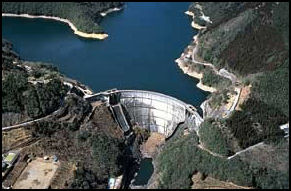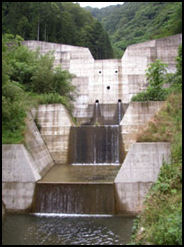WATER IN JAPAN

big dam Percentage of population with access to safe water: 95 percent.
One survey found that 72 percent of Japanese make some effort to conserve water. The survey also found that 37.5 percent of Japanese get their drinking water from the tap; 32 use water purifiers and 29.6 percent drink bottled water. In another survey, 47 percent of Japanese said they don't drink the tap water. Only 28 percent said the tap water tastes good.
Japan is very good at conserving water even though it has a lot of water and doesn’t really need to except in cases of localized droughts. High water prices create an incentive for ordinary people to conserve water. One way Japanese conserve water is by using bath water for several baths and then using the leftover water for washing clothes.
Families in the United States and Japan use 10 times as much water as families in Kenya and dry areas of China. One study found that a three-member Japanese family used 280.7 liters a day compared to 223 liters for a family of 11 in Kenya and 800 liters for a family of four in the United States. Flush toilets account for 24 percent of total household water use. Bath and showers account for 26 percent. Kitchen use accounts for 22 percent.
A survey of one Japanese family found it used 35 percent of its water for washing dishes, house work and for cooking and drinking, 32 percent for baths and showers and 14 percent for washing clothes. In the United States, a family there used 62 percent of its water for baths and showers.
In the 70s only 15 percent of Japanese homes were connected to sewers.
Good Websites and Sources: Water Resources in Japan mlit.go.jp/tochimizushigen ;Thirty Year History of High Roller Concrete Dams in Japan pdf file pwri.go.jp/eng/activity/pdf
Links in this Website: NATURAL RESOURCES AND JAPAN Factsanddetails.com/Japan ; ENVIRONMENTAL ISSUES AND POLLUTION IN JAPAN Factsanddetails.com/Japan ; ; INFRASTRUCTURE AND PUBLIC WORKS IN JAPAN Factsanddetails.com/Japan ;
Dams in Japan

little dam There are lots of dams in Japan. They have been built to generate electricity, control floods and provide irrigation water for agriculture. Japan uses it water supplies very cleverly. Often getting energy, irrigation water, and drinking water from the same dam. Even so many Japanese feel there are too many dams and environmental groups have joined with farmers worried about having their land submerged to protest the construction of new dams.
Share of the worlds dams: 1) China (45 percent); 2) the United States (14 percent); 3) India (9 percent); 4) Japan (6 percent); Other countries (26 percent).
Some prefectures have announced a cessation of all dam projects after they were deemed unnecessary for water supplies and flood control. A concrete dam proposed for a major river in Kumamoto was axed by the governor there on the grounds that it world upset the flow of rivers there that attract large numbers of tourists and fishermen seeking ayu sweetfish. See Nagano mayor.
In 2008, Japan announced plans to build 182 new hydroelectric projects by 2030, up from the 38 it had originally projected, to create construction jobs and boost total hydroelectric power generation to 78.1 billion kilowatt hours.
Tokuyama Dam, Japan’s largest dam in term of water capacity, was opened in May 2008. Plans for the dam, which can hold 650 million tons of water, were announced in 1957 though construction did not begin until 2000. The dam cost $3.5 billion.
Image Sources: 1) Japan Nuclear Power Program 2) Japan Visitor
Text Sources: New York Times, Washington Post, Los Angeles Times, Daily Yomiuri, Times of London, Japan National Tourist Organization (JNTO), National Geographic, The New Yorker, Time, Newsweek, Reuters, AP, Lonely Planet Guides, Compton’s Encyclopedia and various books and other publications.
Last updated March 2010
